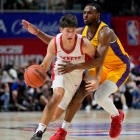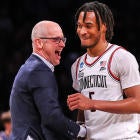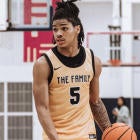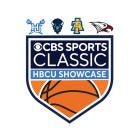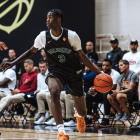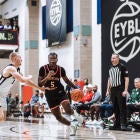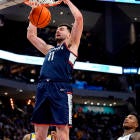What started as a case about a former player suing over video games and other merchandise transformed into something much bigger. Along the way, TV money emerged as the grand prize, current players joined the suit, emails revealed inner workings of NCAA licensing deals, partners sued each other from both sides of the case, and the lawsuit dragged on and on and on.
A look back at some key O'Bannon vs. NCAA events before next week’s trial:
July 21, 2009: Former UCLA basketball star Ed O'Bannon sues the NCAA, Electronic Arts and Collegiate Licensing Company over their use of former players' images in DVDs, video games, photographs, apparel and other material. The law firm Hausfeld LLP, led by prominent class-action lawyer Michael Hausfeld, takes the lead on the case brought by Sonny Vaccaro. Through the years, dozens of firms across the country have contributed to the case.
Feb. 8, 2010: U.S. District Judge Claudia Wilken denies the NCAA's motion to dismiss the lawsuit. The ruling marks a historic step to allow for discovery to examine how college athletes' image rights are sold. Wilken combines O'Bannon's case with former Arizona State and Nebraska quarterback Sam Keller's similar suit against the NCAA and EA.
March 10, 2010: Eleven former college football and basketball players join O'Bannon in the class-action lawsuit. Among the new plaintiffs are two players from the 1966 Texas Western team that fielded the first all-black starting lineup to win an NCAA basketball title. Over the next 19 months, NBA legends Oscar Robertson and Bill Russell join as plaintiffs.
May 5, 2011: Wilken dismisses EA from the lawsuit while keeping the NCAA and CLC as defendants. Wilken says there is no evidence that EA conspired with the NCAA to deny the players compensation. She reverses course on July 28, 2011, and says the ex-players made "significant" new allegations that EA agreed to not offer payments to athletes once their college careers ended.
Aug. 31, 2012: The O'Bannon plaintiffs change strategies. Besides seeking damages for former players largely from video games, they now want to change how current athletes are compensated and add live television money to the equation. Stanford economics professor Roger Noll, an O'Bannon expert, suggests a 50-50 split in TV revenue for players and a one-third split for video games. The change in theory will contribute to trial dates for March 2013 and February 2014 getting delayed.
Nov. 12, 2012: Emails show NCAA officials knew that EA made video games intending to match real-life characteristics of actual college athletes. NCAA director of corporate alliances Peter Davis wrote in July 2003: "We don't actually use player names but we do use all the attributes and jersey numbers of the players."
Jan. 22, 2013: Jon King, the recently fired lead attorney for the O'Bannon plaintiffs, sues his old firm in a scathing lawsuit. King claims he was dismissed after speaking out about the company's "unethical practices," a claim Hausfeld denies. King later agrees in a consent judgment that his claims against Hausfeld and the firm were "incorrect," that he breached confidentiality with his old firm, and that he had apologized to Hausfeld LLP. King's lawsuit reveals that renowned mediator Ken Feinberg is on board with the O'Bannon plaintiffs to distribute money if they win or settle.
Jan. 29, 2013: The O'Bannon plaintiffs survive the NCAA's attempt to end the case before the class can be certified. The NCAA argued the plaintiffs engaged in "gamesmanship" by changing the complaint, but Wilken rules that's not enough to end the case.
March 15, 2013: Big Ten commissioner Jim Delany states in a court declaration he believes Big Ten schools would deemphasize college sports if the O'Bannon suit results in players sharing TV revenue. Delany suggests the Big Ten could even switch to the Division III model, which does not offer athletic scholarships.
May 8, 2013: A deposition gets filed from a former EA executive producer who says video-game avatars were linked to specific player numbers and biographical info. In another deposition, EA executive Joel Linzner says the NCAA approved the games "insofar as they have university rosters with uniform numbers and positions, etcetera." Linzner is scheduled to testify at the O'Bannon trial.
June 6, 2013: The O'Bannon lawsuit reveals the terms of the Pac-12's media rights fees from ESPN and Fox. The Pac-12 received a $30 million signing bonus in 2012 and $185 million in fees in 2013, with the fees increasing 5.1 percent annually until peaking at $321.3 million in 2024.
June 19, 2013: Citing EA documents, the O'Bannon plaintiffs allege the NCAA was incentivized to "look the other way" when EA created a way for consumers to add college players' names in video games. The plaintiffs also say that as early as 2002, EA's video games used broadcast footage from Collegiate Images, then a subsidiary of CLC.
June 25, 2013: Moody's Investors Service revises the NCAA's credit outlook to "negative," largely due to the O'Bannon lawsuit. Moody's will raise concerns again in October 2013 due to public subsidies used on sports, concussion lawsuits and the possible move away from the NCAA amateurism model.
July 18, 2013: Six active college football players join the O'Bannon suit: Vanderbilt's Chase Garnham, Clemson's Darius Robinson, Arizona's Jake Fischer and Jake Smith, and Minnesota's Moses Alipate and Victor Keise. (Kesie would soon leave as a plaintiff.) Wilken had told the plaintiffs they needed a current athlete in order to certify the class.
Sept. 26, 2013: EA and CLC announce they settled all claims by video game plaintiffs. The $40 million proposed settlement, which will allow current athletes to make claims, later gets filed publicly in May 2014 with terms the court must still approve. O'Bannon is set to receive $15,000. Attorneys' fees could comprise 33 percent of the settlement dollars.
Nov. 8, 2013: Wilken partially certifies the O'Bannon class-action suit. She allows the players to collectively challenge the NCAA's current amateurism rules, but rules they cannot seek potentially billions of dollars in damages for appearing in past television broadcasts. Later, it's revealed the plaintiffs had sought $3.2 billion in damages from 2005-06 to 2010-11.
Nov. 20, 2013: The NCAA sues EA and CLC in Georgia state court for failing to protect the NCAA in settlement talks over video games. The NCAA claims it will suffer "irreparable harm" if EA and CLC settle video games and "circumvent their contractual and fiduciary duties owed to the NCAA."
April 11, 2014: As expected, Wilken denies both the NCAA and the O'Bannon plaintiffs' motions for summary judgment. In the process, her opinions shape what the trial may look like.
May 15, 2014: The O'Bannon plaintiffs decide they are no long pursuing individual damages against the NCAA before a jury, instead focusing on the antitrust case to change NCAA rules before a bench trial. The change causes five attempts by the NCAA to delay or redefine the June 9 trial, all of which have so far been unsuccessful. The Keller case over video games gets separated from O'Bannon and is scheduled for trial in March 2015.









